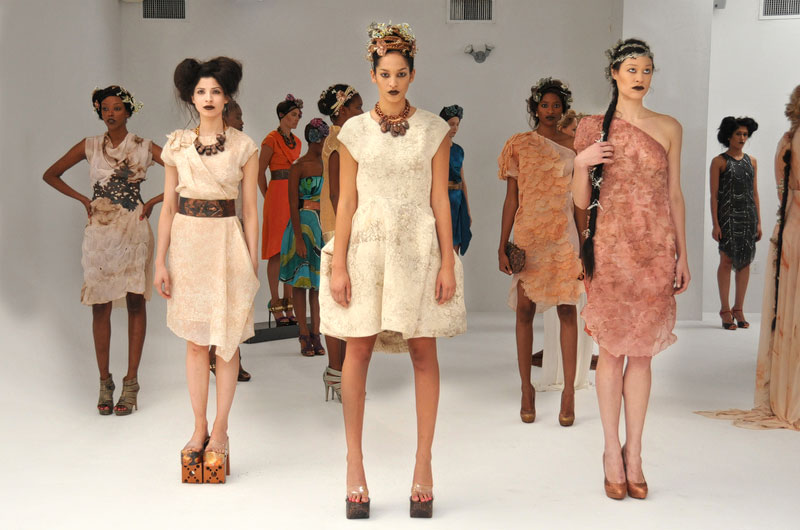
21 Sep Mata’s Atelier shines at New York Fashion Week
By Désirée Prieto of the San Antonio Current
NEW YORK CITY — The entrance to Cult Studios is hidden behind plywood and a closed-off sidewalk when I arrive at the Flower District location near New York City’s Fashion Institute of Technology. Inside, Henry De La Paz, a hairdresser originally from the Rio Grande Valley, is preparing models with weaves, curls, and Princess Leia braids and ribbons for San Antonio designer Angelina Mata’s Spring/Summer 2012 ready-to-wear collection being unveiled at New York Fashion Week.
With 12 years on the ground in San Antonio, and time in L.A., London, and now New York City, De La Paz continues to work with Mata, traveling to San Antonio roughly every five weeks. “I’ve worked with her and her family for eight years,” he says proudly. The all-star cast of San Antonio artists coming together to support Mata’s new line also includes makeup artist Patrick Eichler, whose extensive career includes working with icons such as Alexander McQueen, Valentino and Zac Posen.
When I’m finally ushered into the studio, I find Mata’s Atelier vision showcased in a performance-art installation rather than the traditional runway show. While the approach is said to have been adopted by many fashion designers after 9/11 for budget constraints, it’s continued because of the way it allows an audience to study the designs more deeply. It’s a different but much more rewarding experience.
A dress made with silk organza and “enshrined underground for ten days” was arguably one of Angelina Mata Atelier’s most important pieces of the night, as Mata worked with fiber artist Laura Beehler who helped dye and weather the fabric to create what Mata’s marketing calls a unique “b(earth)ing.” The two buried the five yards of fabric wrapped around a rusty grate, embedded it with rose petals, and kept it wet, as if growing a plant. Once extracted from the ground, the silk organza was turned into a signature bespoke dress with the intention to look antiquated, and indeed it did, as the rust, rose petals, and leaves all left their mark.
Mata says that her silk organza gown, as well as the rest of her line, “translates into a concise ultramodern look with the haunt of ancient civilizations.” This may feel like a familiar trend, however by combining both modern and ancient elements — conforming the long silk organza gown to the body while also allowing it to flow off the body, for example, contributes to a blending of conservatism and progressivism.
However, this exquisite work was less accessible than Mata’s other ready-to-wear outfits, like the fitted, dark pink, off-the-shoulder chiffon dress; a cream A-line knee-length dress; or the stark-white fitted dresses outlined with green and pink. Mata’s tribute to color featured green, orange, and yellow dresses with unique patterns. One of my favorites was the purple skirt with copper belt, which appeared to have large copper medallions printed on it. Large, thick metal belts tied other dresses together as well, however as exciting as the dresses were, the talk of the night were the shoes.
Mata’s shoes were a collaborative effort; furniture artist Peter Zubiate and graphic artist Can2 assisted here, along with metal artist Jose Chapa, who also did all of the metal work for belts. Many of the models appeared to be perched on stilts as they stood on thick wooden platforms stuck to metal extensions — not your typical stiletto. The shoes created a futuristic fairy tale experience, and complemented the models’ vertically pinned thick braids. Some of the braids appeared to be spray painted, others were very pixie-fairy-esque, evoking the fresh appearance of the line. (With their hair down and undone, the models recalled the film Avatar.) In addition, jewelry designer Tracy Stephens helped execute Mata’s earrings.
Mata made it to New York Fashion Week with more than $8,000 in donations largely from the San Antonio community. A thank-you celebration for local friends and supporters is set for November 2 at Blue Star Contemporary Art Center, during which Mata will show the collection against the backdrop of departed SA artist Chuck Ramirez’ work.


